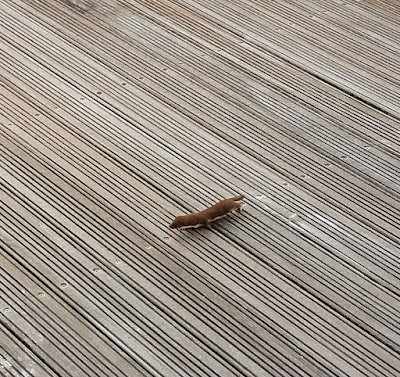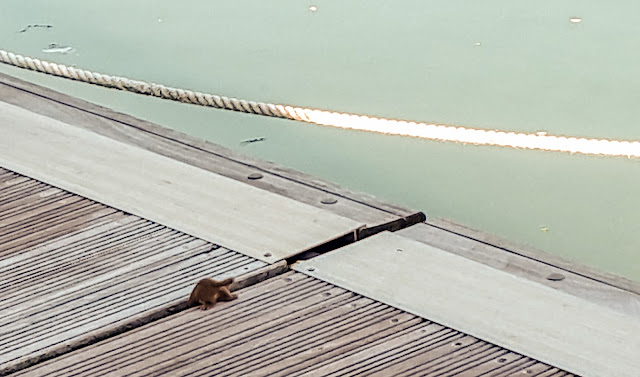 |
Our diesel course certificates |
And it seems we were right to have put off our first trip
out of the marina gates until after we had done the course as it flagged up a
couple of jobs that needed doing before we take Ravensdale out to sea.
John Parlane, of Morecambe-based Bay Sea School, travelled
to Maryport to deliver the RYA Diesel Engine Course on our own boat.
There are two ways to access the engine room – by lifting
the steps that lead down into our bedroom and stepping down onto the floor or
lifting two large sheets of plywood that form most of our sitting room floor
and climbing in from above.
We cleared the sitting room, including removing the bench
that runs along the starboard side of the cabin, lifted the carpet and removed
the boards before John arrived to allow the engine room to cool down a bit as
it was a very warm day.
 |
Ravensdale's two 300hp Volvo Penta engines |
Initially, John explained how a diesel engine works by
showing us a demonstration on our dining table using a Perspex tube sitting on
a block to replicate a piston.
 |
John Parlane's diesel engine demonstration |
He placed a small piece of cotton wool in the bottom as
fuel and pushed a plunger down into the tube at speed causing the cotton wool
to burn.
This was particularly useful for me as I had no idea how
compressing air could create enough heat to run an engine.
He explained that this demonstrated the fire triangle –
air, fuel and heat.
And I can’t repeat Phil’s response when John asked if we
had ever heard of the four stroke cycle – suck, squeeze, bang and blow J
He took as through the basics of the diesel engine using
a presentation on his laptop, answering our questions as we went along.
We then donned our overalls to learn more about the two
300hp Volvo Penta engines that power our Neptunus 133 cruiser.
 |
Checking the oil level using the dip stick |
Conditions in the engine room were not particularly
pleasant due to a lack of headroom when entering under the stairs and cramped
spaces if climbing into the gaps between the engines and the hull on either
side of the boat from above.
At one point, I thought I was well and truly trapped down
the side of the port engine, but I somehow managed to extricate myself.
I’m really going to have to lose some weight if I’m
planning to spend much time in the engine room J
It was also very hot down there so I was pleased when we
returned to the comfort of the seating around our dining room table to complete
our course.
John explained what each part of the engine does, tracing
the routes taken by water, oil and diesel, and explained the importance of the
various checks that need to be carried out at regular intervals.
To help us remember the checks that must be done before
going out to sea and daily while cruising, he suggested we remember the acronym
WOBBLE (definitely a good aide-memoire as I’m never going to forgot a word like
that J).
The letters stand for Water, Oil, Belts, Bilge, Leaks and
Electric, which includes batteries and fuel.
We checked the drive belts on both engines and were
amazed to discover that there are two water pump drive belts and two alternator
drive belts on each engine.
I couldn’t help doing the maths in my head and, even
though I didn’t know the cost of the belts, I calculated that replacing them
all and buying spares was not going to be cheap – especially as they have words
“Volvo Penta” on them J
That was the first time that we realised just how good a
decision it had been not to go to sea before doing the course.
Both of the water pump drive belts on the starboard
engine were slack, one much more so than the other.
John told us how to adjust and change them and Phil
tightened them as much as possible, but they were obviously beyond saving.
 |
Phil tightens drive belts on the starboard engine |
We asked John if he would be happy going to sea with them
as they were and he said that he would not. They really needed to be changed
before moving Ravensdale again.
We also checked the pipes and hoses and discovered that
the fuel return hose on the starboard engine was badly perished and could have
burst at any time – another job that has to be done before we leave the marina.
Other jobs that we need to do asap include replacing
rusty jubilee clips on some of the hoses and tightening some of the connectors
on the battery terminals.
 |
Phil and John checking the bank of batteries on board |
John also showed us how to carry out all the tasks needed
to service the engines, including changing the oil and the air and fuel
filters.
And he ran through the likely causes of various problems
and which ones we could hope rectify ourselves and which really needed the
involvement of an engineer.
Further topics covered included winterising the engines,
although he said that, as we live on Ravensdale, she is unlikely to get as cold
as a boat that is left empty during the winter months.
We now have a list of spares we need to carry to ensure
we are as prepared as possible to deal with any breakdowns.
And we discovered that we didn’t have many of the tools
we needed as most of Phil’s spanners and sockets were imperial when the boat is
Dutch and all the nuts and bolts are metric so we have since been out to get
the tools that will fit.
 |
Phil checks out our new tools |
I am so proud that I now have a certificate stating that
I have successfully completed the RYA Diesel Engine Course to go with my
certificates for the RYA Day Skipper and Yachtmaster Offshore theory courses
and my Short Range Radio Licence.
If anyone had told me 10 years ago – or even a year ago –
that I would complete such courses I would have laughed at them, but I’m so
glad that I’ve done them now and have enjoyed every minute of it.
Over the past few months many people have asked why we
haven’t taken Ravensdale out of the marina yet and we are now very glad we
stuck to our guns.
One other job that has been carried out since our return
from Scotland was replacing the waste water pump for the wash basin in the aft
heads and the shower.
 |
Phil removes the old pump and prepares for the installation of the new one |
It broke down the night we got back from our holiday –
not the best type of welcome home present but not totally unexpected as it had
been making a horrible noise for the past couple of weeks.
We ordered a new Whale Gulper pump (love the name and it
is very descriptive of the noise it makes while operating J) on Sunday and it arrived
Tuesday lunchtime.
 |
The new waste water pump arrives |
Phil had it fitted and working in no time so normal
service was resumed once again.
 |
A weasel runs along the pontoons at Maryport Marina |
Meanwhile, the latest visitor to the marina as far as
wildlife is concerned was a weasel that I spotted on the pontoons as I was
walking down the ramp one morning.
I immediately stood still and watched the tiny creature
scampering along the pontoon, unsure what I was looking at, but determined to
get a photo that would help me identify it.
I managed a couple of shots with my phone, but it was too
far away to get a decent image. However, the images I did get were sufficient
to look it up and it was definitely a weasel.
After running along the pontoon for a while, it came to a
join between two sections, upended itself and dived down into the gap.
 |
The weasel disappears down a gap in the pontoons |
Thanks for post:
ReplyDeletephu kien trung quoc
my pham trung quoc
kinh ap trong trung quoc
giay the thao taobao